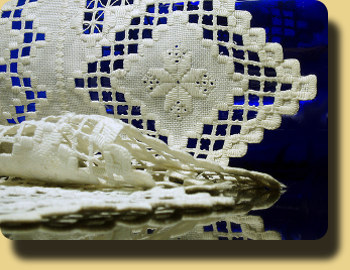
February 2011, Issue 13
Dollhouse Tourism, Norway
Page 59
Some examples of typical historical Norwegian crafts are Hardangersøm, a popular stitchery with very precise, detailed and small designs. By its very nature this craft translates well into miniature scales.
It is sometimes called white work embroidery as it is traditionally worked with
 white thread on white even-weave cloth using counted thread and drawn thread work techniques.
white thread on white even-weave cloth using counted thread and drawn thread work techniques.
The exact origins of Hardanger embroidery are not known, but it is thought to have its beginnings in ancient Persia and Asia. During the Renaissance this early form of embroidery spread to Italy where it evolved into Italian Reticella and Venetian lacework. By 1700 variations of this type of embroidery had spread to northern Europe where it developed further into Danish and Dutch Hedebo, Scottish Ayrshire work and Ruskin lacework as well as Norwegian Drawn Work, as it was then called.
In the period between 1650-1850 Hardangersøm (meaning: work from the Hardanger area) flourished in Norway. Flax was grown, carded, spun and woven into white fabric and thread which was used to make and decorate traditional Norwegian costume items called bunads (national costumes) as well as other items of clothing and household linens such as mats, curtains and bedspreads.
Custom Dolls, Houses & Miniatures / CDHM







